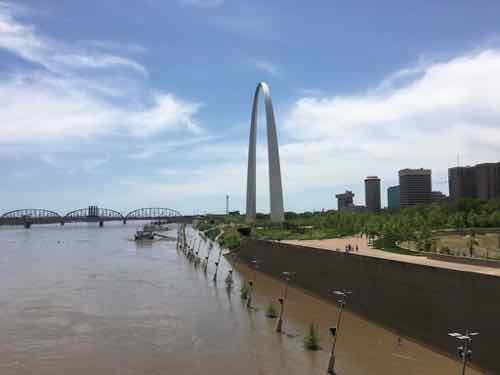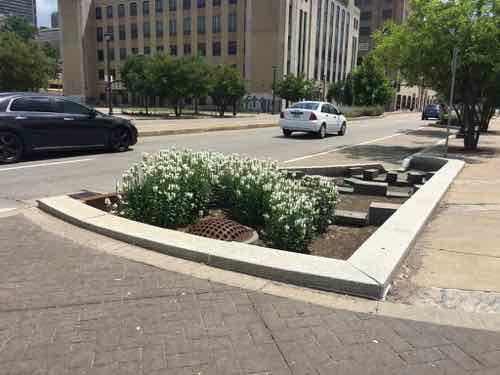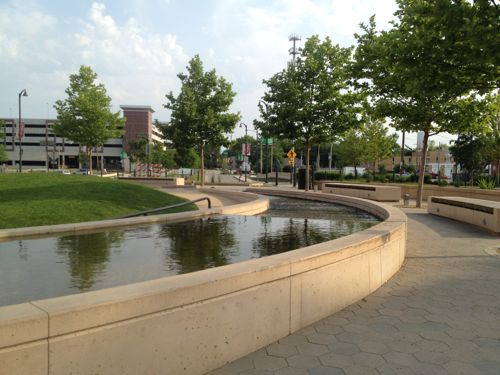The St. Louis Region Should Begin Prepping for Climate Change
June was Earth’s hottest month on record. Mexico had feet of hail (ice) fall on a 90° day. Europe baked with temperatures well above normal. It’s also very hot…in Alaska. India, the second most populist nation, is running out of drinking water. Some are wondering if parts of India are becoming too hot for humans. Just yesterday Mississippi closed all gulf beaches for swimming due to a toxic blue-green algae bloom.
The worst effects of climate change are still decades away, but we’re starting to get a glimpse. While I hope the US gets on board with the rest of the world to slow/stop it before it’s irreversible I’m not optimistic that’ll happen.

So my mind has turned to what should cities, specifically St. Louis, do to mitigate the negative effects. First, we have to determine what we might expect in the future.
The Midwest has gotten warmer, with average annual temperatures increasing over the last several decades. Between 1900 and 2010, the average air temperature increased by more than 1.5°F. The rate of increase in temperature has accelerated in recent decades, particularly nighttime and winter temperatures. Projected change in summer temperatures under different warming scenarios. Summers in Illinois and Michigan might feel like current summers in Texas or Oklahoma by the end of the century.
Precipitation is greatest in the eastern part of the Midwest and less towards the west. Heavy downpours are already common, but climate change is expected to intensify storms and lead to greater precipitation across the entire region during this century. Annual precipitation has already risen by as much as 20% in some areas. Projections of future precipitation indicate that heavy downpours are likely to occur primarily in winter and spring months while summers will become drier, especially in the southern portion of the region. (EPA)
Warmer year around, with wetter & dryer periods. So? From the same source:
In the Midwest, climate change is expected to negatively affect human health in a variety of ways and exacerbate existing health challenges. Major heat waves have been occurring more frequently across this region for many decades, resulting in increased deaths during these extreme events. Heat stress is likely to increase in the future as a result of continued rises in temperatures and humidity in this region, resulting in more heat-related deaths and illnesses. Air quality is already poor in parts of the Midwest and is projected to worsen with rising temperatures. Increased exposure to allergens caused by the lengthening of the pollen season is also expected to negatively impact human health.
Warmer temperatures and changes in precipitation could increase the risk of exposure to diseases carried by insects and rodents. Drinking water quality may also decline as a result of heavier rainfall events.
More on drinking water:
Precipitation in the Midwest is expected become more intense, leading to increased flood damage, strained drainage systems, and reduced drinking water availability. Midwestern cities with impervious infrastructure may result in surface runoff entering combined storm and sewage drainage systems. When these systems are overloaded during intense rainstorms, raw sewage overflow can result, impacting clean water availability and human health.
More heavy downpours may increase the likelihood of property damage, travel delays, and disruption in services. Sediment runoff and erosion may clog reservoirs and reduce storage capacity. Local governments may invest in new infrastructure to prevent contamination and protect water resources.
Expected rises summer drought frequency and evaporation rates could reduce water levels in lakes and wetlands, as well as in important commercial waterways. Disruptions in barge traffic along the Missouri and Mississippi Rivers have already occurred.
Some reports say “end of the century” while others talk about 2050. But it’s happening faster than we previously thought it would.
Again, today’s post isn’t about what we need to do to stop or even slow climate change. Today’s post is my thinking on how we prepare our region for the inevitable. We’re going to feel more like Tulsa initially then more like Dallas. Hot summers with less rain, more humidity — drought. Increased rain in the winter — more flooding.
This year the flooding approached the historic 1993 levels, but has lasted longer. Levees held back water for longer periods, weakening them. It’ll take millions to help them recover. Future flooding may do the same — not exceed 1993 in terms of total height but in length of time. This negatively impacts the local economy as many businesses are closed, employees out of work. So what do we do? We abandon occupying flood-prone lands. Let nature have it back. Build our economy elsewhere.
This is, of course, easier said than done. People have lives, places have history. Towns like Alton & Grafton aren’t suddenly going to stop flooding. It’ll become more frequent and each will be longer. In South St. Louis we’ll see the Mississippi River back up into the River Des Peres again and again. St. Charles County shouldn’t keep building higher and higher levees to try to keep the Missouri River under control.
Increased summer heat & drought means we should be planting massive quantities of shade trees now to lower the urban heat island effect. Fruit trees too so people can harvest the fruit when food production is increasingly hampered by climate change. We need to reduce the amount of impervious surfaces and increase the use of rain gardens to collect runoff.

We can collect storm water in large cisterns to use for irrigation. Uptown Circle in Normal IL is a great example:

Sustainable stormwater management: capturing, storing, cleansing and recycling much of the stormwater in Uptown Normal, is one of the key elements of the project. Run-off is collected from several streets adjoining the Circle and is stored in a 75,000 gallon underground cistern. This cistern, which was recycled from a 60” diameter storm sewer line being abandoned as part of the associated infrastructure improvements, serves as a detention device for water providing relief to the community’s watershed. Water captured and retained in the cistern is then either used for irrigation of turf and plant material in the district or is introduced into the Circle where it begins a journey through a ‘living plaza’ creating a legible demonstration of sustainability in an urban environment. Signage explains the process and value to children and adults.
In the Circle, water collected in the cistern is pumped through a series of terraced filtration bogs where it is cleansed as it flows slowly around the circle through the plant material, passing over several weirs and through a scupper wall before falling into a collection pool. At this point, water is pumped into an underground reservoir, treated by a UV filter and then circulated through a shallow stream-like water feature. Park visitors have access to this highly engaging watercourse as it flows around the circumference of the circle, mirroring the flow of traffic beyond and providing an acoustic buffer to the sound of traffic. This feature also detains and encourages evaporation of water that would have otherwise become runoff as part of a storm event. This process also eases the heat island effect in this urban district. (Architonic)
Commercial properties, apartment complexes, and such will need large cisterns too. Single family homes will need small cisterns for watering shade trees and necessary vegetable gardens.
Older housing needs to be renovated to be far more energy efficient. Large McMansions in the suburbs will not age well, owners will downsize rather than invest the necessary sums to retrofit them. Large amounts of wall area exposed to the hot sun will make them hard to cool. Plant shade trees now. Municipalities will resist the desire to subdivide these excessively large structures into multiple units. There was a time when stately mansions in the Central West End couldn’t be given away (ok, sold for cheap) — we’ll see that with 30-40 year old suburban McMansions.
New housing built should be multi-family but not like our apartment with 3 exterior walls and one shared wall. No, new housing should be like our former loft with 3 shared walls and one narrow exterior wall — a wall that’s often shaded. Of course, this new multi-family housing must including affordability — not just high-end central corridor units.
Auto window tinting is very common in Oklahoma & Texas, we’ll see more of that here — not for privacy but reducing heat gain cars. We’ve tinted our south-facing bedroom windows that get some sun at times of the day. Our 2nd bedroom’s windows have a well-placed shade tree.
There are probably a millions things more we can do collectively as a city/region over the next decade or so to help us handle the future. For those who think climate change is a hoax, just keep your head buried in the sand while the rest of us try to solve fast-approaching problems.
— Steve Patterson